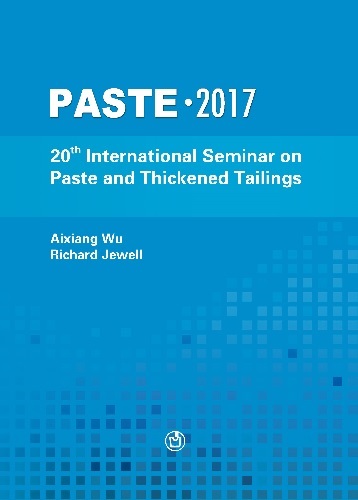Variability of shear yield stress – measurement and implications for mineral processing

|
Authors: Knight, A; Sofrà, F; Stickland, A; Scales, P; Lester, D; Buscall, R |
DOI https://doi.org/10.36487/ACG_rep/1752_07_Knight
Cite As:
Knight, A, Sofrà, F, Stickland, A, Scales, P, Lester, D & Buscall, R 2017, 'Variability of shear yield stress – measurement and implications for mineral processing', in A Wu & R Jewell (eds), Paste 2017: Proceedings of the 20th International Seminar on Paste and Thickened Tailings, University of Science and Technology Beijing, Beijing, pp. 57-65, https://doi.org/10.36487/ACG_rep/1752_07_Knight
Abstract:
At high concentrations, mineral tailings exhibit solid-like behavior up to a critical shear stress, the shear yield stress , which must be exceeded before flow may occur. The magnitude of has a significant influence upon a wide range of important mineral processing operating parameters, including pipeline pressure gradient, thickener operation and tailings beach slope, for example. Although the concept of a critical shear stress is a simple and convenient engineering metric, in practice the transition from solid to fluid-like behavior is much more complicated, resulting in a range of apparent yield stress values that vary with the applied shear conditions. For example, in constant rate or flow start-up rheological testing, the peak stress (one measure of ) can more than double depending on the applied strain rate. In constant stress tests, there is a range of stress over which the slurry exhibits solid behavior over short timescales, but may yield and flow on much longer timescales. Other methods for yield stress determination, such as extrapolation from steady-state stress versus rate data, the onset of non-linearity in oscillatory flows or slump testing can generate an even broader range of yield stress values. Whilst it is neither practical nor desirable to incorporate such complex yielding behaviour into basic models of engineering operations, it is of paramount importance to use an appropriate measure of shear yield stress for a given application. The time and rate dependencies of the selected measurement method must match the time and rate conditions of the intended application. Failure to do so can introduce significant errors with attendant design, operation and cost implications. The present work takes recent insights into the shear rheology of minerals tailings and discusses appropriate measurement techniques for a range of processing applications, including beach slope and pipeline pressure drop prediction, as well the implications of using inappropriate measurement techniques. Rheological measurements of a model system are used to demonstrate the variability of the apparent yield stress with measurement technique. Comparisons with model values of pipeline pressure drop and beach slope are used to demonstrate the scale-up implications of using inappropriate rheological data.
References:
Buscall, R., Kusuma, T.E., Stickland, A.D., Rubasingha, S., Scales, P.J., Teo, H., Worrall, G.L. 2015a, ‘The non-monotonic shear-thinning flow of two strongly cohesive concentrated suspensions’, Journal of Non-Newtonian Fluid Mechanics, vol. 222, pp. 112-120.
Buscall, R., Scales, P.J., Stickland, A.D., Teo, H., Lester, D.R. 2015b, ‘Dynamic and rate-dependent yielding in model cohesive suspensions’, Journal of Non-Newtonian Fluid Mechanics, vol. 221, pp. 40-54.
Clayton, S.A., Grice, T.G., Boger, D.V. 2003, ‘Analysis of the slump test for on-site yield stress measurement of mineral suspensions’, International Journal of Mineral Processing, vol. 70, no. 1-4, pp. 3-21.
Knight, A.P., Sofra, F. 2016, ‘Laboratory studies of two end of pipe treatment technologies: observations and challenges’, in S. Barrera and R.J. Jewell (eds), Proceedings of the 19th International Seminar on Paste and Thickened Tailings, Gecamin, Santiago, pp. 36 – 46.
Liu, K. F. and Mei, C.C. 1989, ‘Slow spreading of a sheet of bingham fluid on an inclined plane’, Journal of Fluid Mechanics, vol. 207, pp. 505-529.
Nguyen, Q.D. and Boger, D.V. 1998, ‘Application of rheology to solve tailings disposal problems’, International Journal of Mineral Processing, vol. 54, no. 3-4, pp. 217 – 233.
Nguyen, Q.D. and Boger, D.V. 1985, ‘Direct yield stress measurement with the vane method’, Journal of Rheology, vol. 29, no. 3, pp. 335-437.
Nguyen, Q.D. and Boger, D.V. 1983, ‘Yield stress measurement for concentrated suspenions’, Journal of Rheology, vol. 27, no. 4, pp. 321-349.
Pashias, N., Boger, D.V., Summers, J.L., Glenister, D.J. 1996, ‘A fifty cent rheometer for yield stress measurement’, Journal of Rheology, vol. 40, no. 6, pp. 1179-1190.
Seddon, K.D., Pirouz, B., Fitton, T.G. 2015, ‘Stochiastic beach profile modelling’, in R.J. Jewell and A.B. Fourie (eds), Proceedings of the 18th International Seminar on Paste and Thickened Tailings, Australian Centre for Geomechanics, Perth, pp. 455-466.
Simms, P., Williams, M.P.A., Fitton, T.G., McPhail, G. 2011, ‘Beaching angles and evolution of stack geometry for thickened tailings – a review’, in R.J. Jewell and A.B. Fourie (eds), Proceedings of the 14th International Seminar on Paste and Thickened Tailings, Australian Centre for Geomechanics, Perth, pp. 323-338.
Sofra, F. and Boger, D.V. 2002, ‘Environmental rheology for waste minimisation in the minerals industry’, the Chemical Engineering Journal, vol. 86, no. 3, pp. 319-330.
Sofra, F. and Boger, D.V. 2011, ‘Rheology for thickened tailings and paste – history, state-of-the-art and future directions’, in R.J. Jewell and A.B. Fourie (eds), Proceedings of the 14th International Seminar on Paste and Thickened Tailings, Australian Centre for Geomechanics, Perth, pp. 121-134.
Stickland, A.D., Kumar, A., Kusuma, T.E., Scales, P.J., Tindley, A., Biggs, S., Buscall, R. 2015, ‘The effect of premature wall yield on the creep testing of strongly flocculated suspensions’, Rheologica Acta, vol. 54, no. 5, pp. 337-352.
Van Deventer, B.B.G., Usher, S.P., Kumar, A., Rudman, M.,Scales, P.J. 2011, ‘Aggregate densification and batch settling’, Chemical Engineering Journal, vol. 171, no. 1, pp. 141-151.
© Copyright 2026, Australian Centre for Geomechanics (ACG), The University of Western Australia. All rights reserved.
View copyright/legal information
Please direct any queries or error reports to repository-acg@uwa.edu.au
View copyright/legal information
Please direct any queries or error reports to repository-acg@uwa.edu.au